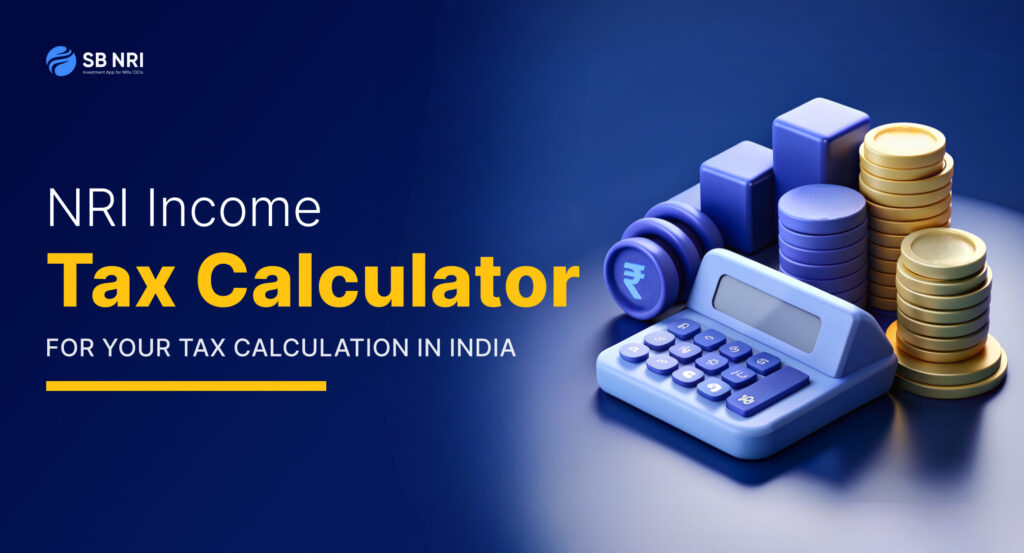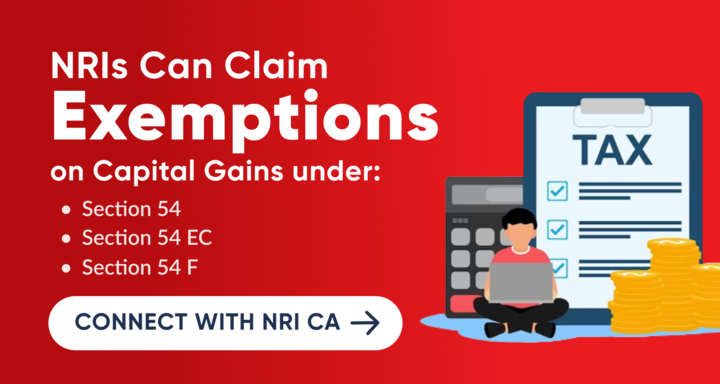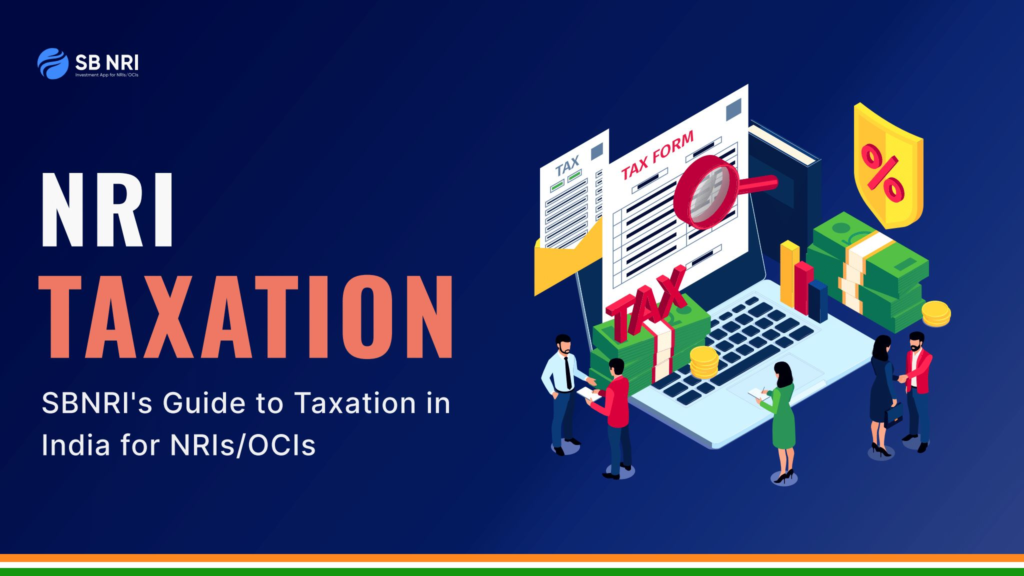
Income Tax for NRIs is quite a complex and confusing aspect of financial management. However, with the advent of technology and online tools, calculating taxes has become more accessible and convenient. One such tool that has gained popularity among NRIs is the NRI Income Tax Calculator. In this blog, we will explore the functionality and benefits of the NRI Income Tax Calculator, shedding light on how it can help NRIs effectively manage their tax obligations.
What is NRI Income Tax Calculator?
The NRI Income Tax Calculator is an online tool designed to assist NRIs in evaluating their tax obligations based on their income, as outlined in the Union Budget 2023-24. For those falling within the taxable income bracket, a specific portion of their net annual income must be paid as taxes. These taxes can be settled either through tax deduction at source during the monthly salary disbursement or via the income tax returns portal managed by the Central Board of Direct Taxes (CBDT).
How to use NRI Income Tax Calculator?
Using an Income Tax Calculator is straightforward and involves a few simple steps. Here’s a step-by-step guide to using an Income Tax Calculator:
- Enter Personal Details: Begin by entering basic personal details such as age, gender, and residential status. This is important as tax slab rates and exemptions can vary based on these factors.
- Input Income Details: Provide information about your total income from various sources. This includes salary, business income, rental income, capital gains, and any other sources of income.
- Deductions and Exemptions: Enter details of deductions and exemptions you are eligible for. This can include investments under Section 80C (like PPF, EPF, NSC, etc.), health insurance premiums under Section 80D, education loan interest under Section 80E, and others.
- Taxable Income Calculation: The calculator will subtract the total deductions from your gross income to arrive at the taxable income.
- Tax Computation: The calculator will subtract the total deductions from your gross income to arrive at the taxable income.
- View Result: The final step is to view the result, which will show your total tax payable, including a breakdown of the calculations.
Income Tax Calculators are available on various websites, including the official Income Tax Department website, financial portals, and banking websites. Using these calculators can save time and help avoid errors in manual calculations. You can also use SBNRI’s Income Tax Refund Calculator and calculate your TDS refund for the financial year.
Benefits of Using Income Tax Calculator for NRIs and OCIs
Using an income tax calculator streamlines the process of estimating your taxes and ensures you consider all potential tax-saving opportunities. The greatest advantage is that NRIs can use this calculator at any point during the financial year.
Given below are the benefits of using the income tax calculator:
- User-friendly interface
- Accessible 24/7
- Streamlines tax calculation
- Assists in identifying deduction possibilities
- Calculates potential tax liability in advance

What is TDS?
Tax Deducted at Source (TDS) is a mechanism introduced by the Income Tax Department of India to collect tax at the source of income. Under this system, the person responsible for making payments of a specified nature (such as salary, rent, interest, professional fees, etc.) is required to deduct a certain percentage of tax before making the payment to the recipient. The deducted tax is then deposited with the government.
TDS helps in the timely collection of taxes and reduces the burden on taxpayers to pay the entire tax at the end of the financial year. It also helps in spreading the tax collection process throughout the year, ensuring a steady flow of revenue to the government.
For example, employers deduct TDS from employees’ salaries based on their estimated income and applicable tax slabs. Similarly, banks deduct TDS on interest earned on fixed deposits if it exceeds a certain threshold. The TDS deducted is reflected in the recipient’s Form 26AS and can be claimed as a credit while filing their income tax return.
What is TDS Refund?
A TDS refund is the process of reclaiming the excess tax deducted at source by the payer if the actual tax liability of the taxpayer is lower than the TDS deducted. This situation typically arises when the income tax calculated on the total income is less than the TDS already deducted.
To claim a TDS refund, taxpayers need to file an income tax return (ITR). The Income Tax Department processes the ITR and verifies the details. If the tax department finds that the TDS paid is more than the actual tax liability, the excess amount is refunded to the taxpayer.
The refund process involves the following steps:
- File ITR: Ensure that you file your income tax return before the due date, declaring all sources of income and TDS deducted.
- Verification: After filing the ITR, verify it using methods such as Aadhaar OTP, EVC generated through a bank account, or by sending a signed ITR-V to the Centralized Processing Center (CPC) of the Income Tax Department.
- Processing: The tax department processes the return, matches the TDS claimed with the TDS details available in Form 26AS, and calculates the refund amount.
- Refund Issuance: Once the return is processed and approved, the refund amount is credited to the bank account provided in the ITR.
It’s essential to provide accurate bank details and ensure that the KYC norms are fulfilled to avoid any delays in the refund process.
How to use TDS Refund Calculator?
A TDS Refund Calculator helps taxpayers estimate the refund amount they are eligible for if excess TDS has been deducted. Here’s how to use a TDS Refund Calculator:
- Enter Income Details: Start by entering your total income from various sources like capital gains, rental, and interest income for the financial year.
- Input TDS Details: Provide the details of TDS deducted on different incomes. This information can be obtained from Form 16 (for salaried individuals), Form 16A (for non-salaried individuals), and Form 26AS.
- Claim Deductions: Enter the details of deductions you are eligible for under different sections of the Income Tax Act.
- Calculate Tax Liability: The calculator will compute your total tax liability based on the income and deductions provided.
- Determine TDS Refund: It will then compare the total TDS deducted with the tax liability calculated. If the TDS deducted is higher, it will show the excess amount as the TDS refund.
Using a TDS Refund Calculator can help you plan your finances better and ensure that you claim the correct refund amount while filing your ITR.
Determining NRI Status
The Foreign Exchange Management Act (FEMA) has provided guidelines to determine the residential status of an individual. According to the Indian Income Tax Law, an individual will be classified as a resident Indian for a particular year if they meet any of the following criteria:
1. The individual has resided in India for a minimum of 182 days during the financial year.
OR
2. The individual has resided in India for at least 60 days in the year and for a minimum of 365 days in the preceding four years.
If an individual satisfies either one or both of these conditions, they will be considered a resident. If none of the conditions are met, the individual will be categorized as a Non-Resident Indian (NRI).
Is NRI Income Taxable?
If you have the status of ‘NRI’, any income earned or accrued in India will be subject to taxation in India.
Examples of income earned or accumulated in India include:
- Salary received within India or for services provided in India
- Income from a property located in India
- Capital gains from the transfer of assets situated in India
- Income from fixed deposits or interest on a savings bank account.
All these types of income are taxable for an NRI.
Income that is earned outside of India, however, is not subject to taxation in India.
NRI Taxation in India: New Rules
The following points outline the new rules for NRI taxation in India:
- As per the Finance Act of 2020, Indian citizens who earn over Rs 15 lakh from sources within India will be considered residents of India, provided they are not obligated to pay taxes in any other country.
- If an individual’s total income (excluding income from foreign sources) is up to Rs 15 lakh, the 60-day criterion is extended to 182 days. Additionally, if an Indian citizen is leaving India for employment outside the country, the 60-day condition is extended to 182 days.
Tax on NRI Income
Provided below is a comprehensive overview of taxable income for NRIs in India:
Income from Salary
- If an NRI receives a salary in India, it becomes subject to taxation in India. Therefore, any salary earned by an NRI for services rendered within India is taxable.
Income from House Property and Loans
- Income generated from a vacant or rented house property in India is taxable according to the prevailing rates.
- The income tax regulations state that any capital gains resulting from the lease, sale, or rent of a property in India are taxable.
- Similar to Indian residents, NRIs can claim a deduction of up to 30% on their home loan in India. Additionally, deductions for principal repayment, registration fees, and stamp duty under Section 80C are also applicable to NRIs.
- If a tenant pays rent to an NRI property owner, a Tax Deducted at Source (TDS) of 30% must be deducted before transferring the funds to the NRI’s account. The person making the payment to the NRI is required to file Form 15CA/15CB online with the Income Tax Department.
Income from Capital Gains
- Capital gains arising from long-term or short-term securities in India are subject to taxation.
- Capital gains on shares held in Indian companies are also taxable.
- The transfer of an asset in India resulting in capital gains is subject to taxation.
Income from Investments
- NRIs who invest in assets in India are taxed at a rate of 20%. If Tax Deducted at Source (TDS) has been deducted on the investment income, filing returns is not mandatory. Certain investment assets in India qualify for special treatment, as listed below:
- Central government securities
- Shares in Indian companies
- Deposits
- Debentures (for publicly listed companies)
Income from Other Sources
Income sourced from India, such as interest earned on fixed deposits and savings accounts, is taxable in India. Interest received on NRO (Non-Resident Ordinary) accounts is fully taxable, while interest received on NRE (Non-Resident External) and FCNR (Foreign Currency Non-Resident) accounts is exempt from tax.
NRI Income Tax Slab Rates
One of the most significant updates in 2025 is the introduction of new income tax slabs, replacing the earlier structure. The revised tax brackets aim to simplify taxation while keeping rates largely consistent.
For NRIs, the new tax slabs are:
| Annual Income (INR) | Tax Rate (%) |
| Up to ₹4,00,000 | 0% |
| ₹4,00,001 – ₹8,50,000 | 5% |
| ₹8,50,001 – ₹12,50,000 | 10% |
| ₹12,50,001 – ₹16,50,000 | 15% |
| ₹16,50,001 – ₹20,00,000 | 20% |
| ₹20,00,001 – ₹25,00,000 | 25% |
| Above ₹25,00,000 | 30% |
This change provides a clearer tax structure without increasing the tax burden on NRIs.
Checkout the old Income Tax Slabs rates for the FY 2023-2024

Can NRIs Avail any Tax Deductions?
Yes. NRIs, similar to resident Indians, have the opportunity to claim various deductions and exemptions from their income in India. The deductions that NRIs are eligible for include:
a. Under Section 80C
- Premiums paid for LIC (Life Insurance Corporation) policies
- Tuition fees for education
- Repayment of principal on home loans
- Investments in ULIPs (Unit Linked Insurance Plans)
- Investments in ELSS (Equity Linked Savings Schemes)
b. Under Section 80D
- Medical insurance premiums
c. Under Section 80E
- Interest paid on education loans
d. Under Section 80G
- Donations made to eligible charitable organizations
e. Under Section 80TTA
- Under Section 80TTA, NRIs can claim a deduction on income from interest earned on savings bank accounts.
While computing your income tax return, you may need to enter these exemptions into NRI income tax calculator.
Do NRIs Need to File ITR in India?
Non-Resident Indians (NRIs) should file an Income Tax Return (ITR) in India if they meet any of the following conditions:
- Their total income in India exceeds the basic exemption limit.
- They want to claim a refund for excess TDS deducted.
- They have any income earned from investments, property, or any other source within India.
NRIs are only taxed on the income that is earned or accrued in India. Income earned outside India is not taxable for NRIs. Common types of income that NRIs might need to report include:
- Rental income from property in India
- Capital gains from the sale of assets or securities
- Interest income from savings accounts, fixed deposits, and other investments in India
Filing ITR is essential for NRIs to comply with Indian tax laws, avoid penalties, and ensure that they can claim refunds or carry forward losses for future adjustments.

Is Filing ITR mandatory for NRIs in India?
Many NRIs/OCIs do not file their income tax returns in India basis the assumption that their foreign source funds aren’t taxable in India. However, there may be transactions that they have performed in India that require them to file an NRI Income Tax Return. In many cases, NRIs/OCIs with income less than the exemption limit, i.e. Rs 2.5 lacs do not file the returns, again with the assumption that they are exempt from taxation liability.
But there are conditions where an NRI/OCI needs to file an ITR even if the income is less than Rs 2.5 lacs in India. Here are those:
- If you have deposits or aggregate of more than 1 cr in one or more current accounts
- If you spend more than 2 lacs on foreign travel
- If you spend more than 1 lacs on electricity expenditure
Furthermore, there are three additional cases where they need to file ITR for NRI in India:
- Occupant of immovable property
- Holder of credit card (Not add-on card)
- Owner or lessee of motor vehicle
Due to these discrepancies and cases where NRIs/OCIs have missed their ITR returns, Income Tax department may issue a notice or intimation to the user to verify the tax evasion and liability. It is advised that NRIs file ITR returns to abide by the compliance and avoid any notices.
When is the Last Date or Due Date to fill ITR?
The last date or due date to fill your Income Tax Return(ITR) in India is July 31st for individuals, Non-Resident Indians (NRI) or Overseas Citizen of India (OCI), and HUFs. With the announcement of new tax regimes, there are two tax regimes you can choose from, new tax regime and old tax regime. Any individual, NRI/OCI, or HUF needs to select the right tax regime as per their suitability while filing an ITR.
However, it is also to be noted that from this year onwards, the New Tax regime would be the default tax regime for ITR filing unless the assessee selected another regime. To guarantee your option is recorded and to avoid penalties, don’t forget to file by July 31st. If you do not file ITR by due date then you will be liable for penalty for non-filing of ITR.
Calculate your TDS Refund with SBNRI’s TDS Refund Calculator
A TDS refund is the process of reclaiming the excess tax deducted at source by the payer if the actual tax liability of the taxpayer is lower than the TDS deducted. This situation typically arises when the income tax calculated on the total income is less than the TDS already deducted. To claim a TDS refund, taxpayers need to file an income tax return (ITR). The Income Tax Department processes the ITR and verifies the details. If the tax department finds that the TDS paid is more than the actual tax liability, the excess amount is refunded to the taxpayer.
You can easily find out how much tax refund you can get by calculating your TDS Refund from this TDS Refund Calculator.
Access SBNRI’s Exclusive NRI Taxation Guide

NRIs and OCIs can now access SBNRI’s exclusive NRI Taxation Guide covering in-depth information about DTAA, Gift Tax, Rental Income Tax, ITR Filing, Types of ITR Forms for NRIs, Capital Gain Tax, Income Tax, and more. The report will help you understand India taxation on mutual funds, other asset classes and how you can comply with the regulations.
Access NRI Taxation Guide here
Wrapping Up
An NRI Income Tax Calculator is an invaluable tool for NRIs to accurately estimate their tax liabilities in India. By understanding the key components and using the calculator effectively, NRIs can ensure compliance with Indian tax laws, optimize their tax savings, and plan their finances more efficiently. Regularly reviewing and updating your financial information in the calculator will help you stay informed about your tax obligations and make informed financial decisions.
Looking for NRI ITR Filing? Connect with SBNRI NRI Tax Expert CA Today!

At SBNRI, we have simplified ITR filing for NRIs/OCIs through a smooth digital journey. Be it Basic Filing, Advanced Filing (includes Capital Gain, etc.), or Premium Filing (Foreign Income), we can help you assess the right computation and lower your tax liability.
“We’ve helped over 500+ NRIs/OCIs file ITR returns and more than 25,000+ across other taxation services last financial year and we’d love to help you out too”
You can download SBNRI App or connect with NRI Tax Expert team directly via the button below.
FAQs
What is Income Tax Calculator?
An Income Tax Calculator is an online tool that helps individuals estimate their tax liability based on their income, deductions, and other relevant details. These calculators are designed to provide a quick and accurate calculation of the income tax one needs to pay for a particular financial year. They are user-friendly and can be used by anyone with basic knowledge of their income and expenses.
Can NRI claim income tax refund?
NRIs can claim exemptions on long-term capital gains under Sections 54, 54EC, and 54F. NRIs can claim benefit from these exemptions when filing returns and claiming a refund for the TDS deducted from capital gains.
How long is the income tax refund process?
Income tax refunds process can be done easily through online mode. Once the assessee has filed their ITR return and verified the income, income tax refunds are processed within 3-5 weeks after the processing of ITR.
How to check refund status of income tax?
To check the status of your income tax refund, visit the official Income Tax e-filing portal and log in to your account. Navigate to the ‘My Account’ section and select ‘Refund/Demand Status’. Alternatively, you can check the status on the TIN NSDL website by providing your PAN and assessment year details.
What documents are required for NRI tax return?
- For Rental Income- Bank statement would work if it shows monthly receipts of Rental Income and the exact address of the property held for rent with the name of the Tenant.
- For Interest Income- NRO and NRE Bank statement.
- For LTCG/STCG- Capital Gain statement for FY 23-24.
- Foreign Tax ID and Number of Days spent in India for FY 2023-24 and from FY 2019 till 2023.
- PAN card.
How to show NRI income in ITR?
Many NRIs have taxable income in India like rent, dividends, capital gain, etc. Since these incomes are deemed to be accrued and arised in India, they must file ITR for NRIs to comply with the regulations. Here’s how you can show NRI Income in ITR:
- Select the Correct ITR Form: Choose the appropriate ITR form based on your income sources. For NRIs, this is usually ITR-2 or ITR-3.
- Residential Status: Confirm your residential status as NRI in the form.
- Foreign Income: Report any foreign income under the section for ‘Income from Other Sources’ if it is taxable in India.
- Indian Income: Declare all income earned or accrued in India, such as salary, rental income, capital gains, or interest from bank accounts.
- Exemptions and Deductions: Claim applicable exemptions and deductions for which you are eligible, such as under Sections 80C, 80D, 80G, etc.
- DTAA Benefits: If your foreign income is taxed in another country with which India has a Double Taxation Avoidance Agreement (DTAA), provide details to claim relief.
- Verification: Verify and submit your return after filling in all necessary details.
Ensure all income, whether earned in India or abroad, is accurately reported to avoid penalties.



